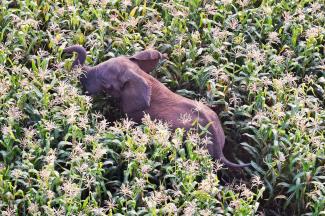March 2017—Wilson Sairowua grew up just outside Kenya’s Narok town, the gateway to the famous Masai Mara Game Reserve, at a time when mobile phones were rare and elephants were aplenty.
Over the past 20 years, while rural communities have increased connectivity and access to mobile technology, the elephant population has significantly decreased, and these wonderful creatures’ future is now dire.
“I remember seeing elephants in the near distance when we looked outside the window at home or when we were on the way to school. But this has changed. Why have the elephants moved? Surely we can change it back and live in harmony again,” says Sairowua as he looks out over the grasslands of the Mara. His keen eye alternates between combing the horizon for any wildlife and peering at his mobile phone waiting for the inevitable blip that displays the exact location of each of the 22 collared elephants in the Mara.
Over the last two decades, poaching and illegal wildlife trade as well as human-wildlife conflict in and around protected areas in Kenya have been on the rise, posing a great threat to the country’s biodiversity and wildlife-based tourism industry, which accounts for 25 percent of Kenya’s gross domestic product and more than 10 percent of formal sector employment.
At the same time, a rising population in Kenya has necessitated land-use changes to increase agricultural production, basic infrastructure, and rural and urban development. The changing climate has also had ravaging impacts on ecosystems and wildlife, including a drastic reduction of open lands, vegetation and water, which threatens the extinction of wildlife that depend on large natural areas for breeding and feeding.
In response, the USAID-funded Planning for Resilience in East Africa Through Policy, Adaptation, Research and Economic Development (PREPARED) project worked with 35 conservation managers and community game scouts in Kenya and Tanzania in 2016 to use technology to improve the monitoring, reporting and analysis of wildlife information in national and community protected areas.
The mobile application and cloud-based system, aptly named WILD (Wildlife Information Landscape Database), was created through a three-year participatory process. WILD is a locally developed, open-source app that supports the improved collection, sharing and analysis of biodiversity information and data. Developed by Strathmore University’s iLabAfrica Centre, the app allows community game scouts in the Mara and elsewhere to collect information on any smart mobile phone and immediately relay it back to the conservancy headquarters.
“Before we had WILD, our work was difficult. The rangers had to carry so many things while out on patrol. They had phones, camera, notebooks, pen and radios,” says Sairowua as he sorts through the latest data sent through by a ranger. “So when they came across an incident, they would lose time recording it, and maybe the poachers were still in the area and they would miss catching them. Now, they only have to carry one thing—their phones. As a team, we are much faster now and more efficient at responding to situations. This technology will take us far.”
The secure online database allows Sairowua, who manages the data for the Mara Elephant Project, a PREPARED grantee, to analyze the data and use it to make conservation management decisions, such as identifying hotspots that need intensified intervention. The app is user-friendly—visuals make it easier for semi-literate users—and has a Swahili language option.
“Technology can help us monitor and evaluate biodiversity issues on a real-time basis. It also allows us to create a chain of events that we can use to forecast and respond in a manner that is immediate and effective,” says Juniper Neill, chief of the environment office in USAID’s Kenya and East Africa mission.
PREPARED has also been working with partners in the Mara-Serengeti and Amboseli-Kilimanjaro ecosystems to pilot innovative approaches to combat human-wildlife conflict. These successful pilots include planting chili pepper fences to deter elephants, tracking collared elephants to predict areas of conflict and respond rapidly, creating living walls (vertical gardens) around livestock corrals, and using high-intensity lights as a deterrent around fields at night.
Through these community-based solutions to human-wildlife conflict and technological advances like WILD, great progress has been made in preserving threatened and endangered species and conserving biodiversity in the Mara and elsewhere. For example, Honeyguide Foundation, a Tanzania conservation organization and another PREPARED grantee, mitigated over 900 human-wildlife conflicts in the West Kilimanjaro region using these new techniques. WILD will assist these efforts by providing community scouts like Wilson the tools to monitor these conflicts and achieve the twin objectives of conserving East Africa's ecosystems and improving rural livelihoods.
With continued success, when Sairowua’s daughter, Sarah—who is less than a year old now—looks through the window in a few years, the elephants that roam the Mara will be as ubiquitous as the smartphones used to protect and conserve them.
The PREPARED program runs from 2012 to 2017 in Kenya, Tanzania, Uganda, Burundi and Rwanda. In addition to wildlife conservation, the program works to increase resiliency to climate variability, manage transboundary freshwater biodiversity conservation, and improve access to drinking water supply and sanitation services. Achievements include developing analytical tools to address climate variability; assisting investment planning for biologically significant areas; and introducing creative ways to reduce public utility water loss resulting from leakage, dysfunctional meters or illegal connections.
LINKS
,“As a team, we are much faster now and more efficient at responding to situations. This technology will take us far.”

Mara Elephant Project/Marc Goss
